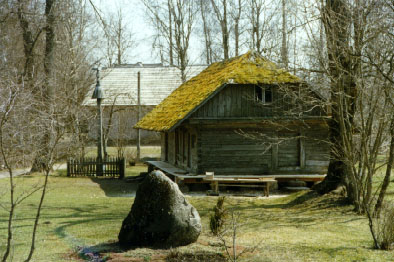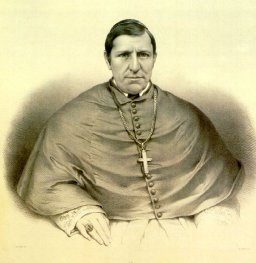- Motiejus Valancius Birthplace-Museum was founded in 1969 in the
Nasrenai (Kretinga District). The only
authentic building – a store-rooms granary, is left in the farm-stead of the 19th
century. The best of Motiejus Valancius’ works come together in the native land of the
bishop’s birth anniversary of 200, two hundred small oaks were planted near the
farm-stead.

- Motiejus Valancius (1801-1875), bishop of Samogitia, historian and writer, born into a
well-to-do peasant family in Nasrenai village, county of Kretinga, on February 16, 1801.
Early in his youth, he had his baptismal records altered to indicate noble birth; the
family name was Polonized to Wolonczewski. This practice, not uncommon among prosperous
villagers, was a means of providing educational opportunities otherwise denied to peasant
children. In 1816 he entered the Dominican school at Zemaiciu Kalvaria and six years later
began his studies at the Theological Seminary in Varniai. He transferred to the Supreme
Seminary at Vilnius in 1824, from which he graduated in 1828. Ordained a priest that same
year, he spent the next six years teaching religion in Belorussia. In 1834 he returned to
Lithuania to take up a teaching position at the Kraziai secondary school. In 1840 he was
assigned to the Vilnius Theological Academy, where he lectured in pastoral theology and
biblical archaeology and where he earned his doctorate in theology in1842. That same year
on orders of the Tsar, the Academy, it teaching staff and student body, was moved to St.
Petersburg, Russia. Valancius came back to Lithuania for reasons of health in 1845 and was
appointed rector of the Varniai Theological Se minary, serving in this capacity until 1850. minary, serving in this capacity until 1850.
- Having been absent from Lithuania during the anti-Russian uprising in 1831, Valancius
was considered to be relatively apolitical, and thus the Russian government did not object
when he was proposed as Episcopal candidate for the see of Samogitia. He was consecrated
bishop in 1850, the first peasant to over head that prestigious diocese. Taking up his
duties, he guided the diocese for the next 25 years, years of religious, political and
social change not only within Samogitia but in Lithuania as a whole. He expanded and
improved the Samogitian parochial school network, wrote a great many religious books, and
in 1858 inaugurated a temperance movement, which grew to encompass nearly a million
members, almost half of the county’s population. His pastoral and educational work was
interrupted by the uprising of 1863)1864 and was made extremely difficult as the Russian
government tightened its reins after the collapse of the revolt. Yet these circumstances
did not prevent him from following a course which could not but bring him into direct
conflict with the authorities. He made every effort to undermine the government’s scheme
of Russification. In 1874 Valancius fell seriously ill and died in Kaunas on may 29, 1875.
- He services to the Lithuanian cause were lasting and important. His opposition to the
Russian government and the tactics he employment in resisting its policies, particularly
the illegal practice of printing Lithuanian books in East Prussia and smuggling them into
Lithuania, served to stimulate the emergence of the Lithuanian national movement. An
educator, an able Church administrator, historian and ethnographer, and a talented writer,
Valancius emerges as one of the most versatile and influential figures in nineteenth
century Lithuania.
-
Photos from the archives of the Information Centre of
Samogitian Cultural Association
-
|

